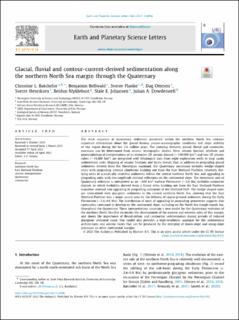| dc.description.abstract | The thick sequence of Quaternary sediments preserved within the northern North Sea contains important information about the glacial history, palaeo-oceanographic conditions and slope stability of this region during the last 2.6 million years. The interplay between glacial, fluvial and contouritic processes can be determined from seismic stratigraphic studies. Here, seismic horizon, attribute and geomorphological interpretations of an extensive 2D seismic dataset (∼100,000 km2) and two 3D seismic cubes (∼18,400 km2) are integrated with lithological data from eight exploration wells to map sandy sedimentary units. Mapping of seismic horizons and facies reveals that, in addition to prograding glacial sediments derived from the Norwegian mainland, the Quaternary succession includes wedge-shaped units with prograding internal clinoforms building out from the East Shetland Platform, relatively flat-lying units of acoustically stratified sediments within the central northern North Sea, and aggrading to prograding units with low-amplitude internal reflections on the continental slope. The lowermost unit of Quaternary sediment is interpreted as an ∼800 km3 earliest Pleistocene (∼2.6 Ma) turbidite-contourite deposit, in which turbidites derived from a fluvial delta building out from the East Shetland Platform transition seaward into aggrading to prograding sediments of the Shetland Drift. The wedge-shaped units are intercalated with glacigenic sediments in the central northern North Sea, showing that the East Shetland Platform was a major source area for the delivery of coarse-grained sediments during the Early Pleistocene (∼2.6–0.8 Ma). The distribution of units of aggrading to prograding geometries suggests that contourites continued to develop on the continental slope, including on the North Sea trough-mouth fan, throughout the Quaternary. These interpretations constrain a new model for the Quaternary evolution of the northern North Sea that reconciles the development of the eastern and western sides of this margin, and shows the importance of fluvial-deltaic and contouritic sedimentation during periods of reduced glacigenic sediment input. Our model also provides a high-resolution analogue for the sedimentary architectures and seismic facies that can be produced by the interplay of down-slope and along-slope processes on other continental margins. | en_US |

